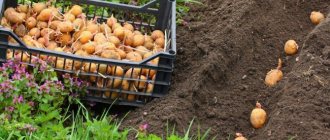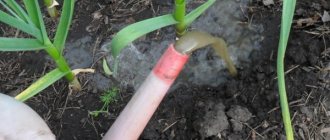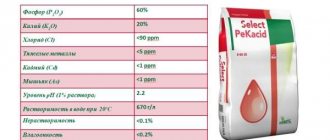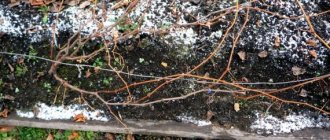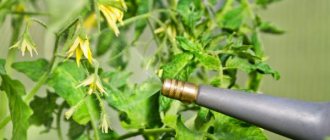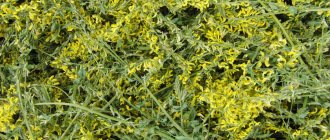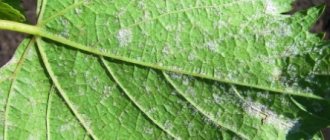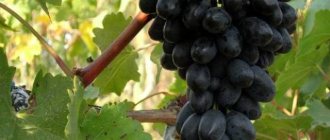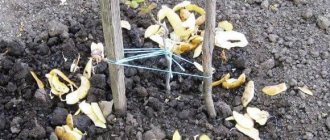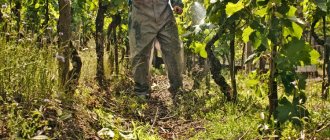Grapes are a wonderful, unpretentious fruit-bearing plant. But for normal development and increased productivity, it, like any other cultivated plant, needs feeding.
When planting a grapevine, fertilizers are applied. They will last no more than 3-4 years, since after this time the plant will get stronger and begin to bear fruit.
After the harvest is harvested, it is necessary to replenish the reserves of useful microelements and minerals.
This is why autumn feeding . It is produced annually. Also, once every 2-4 years, depending on the type of soil, it is necessary to make the main application of fertilizers to the soil. This will not only allow the vine to fully recover after the fruiting period, but will also increase its yield for the next year. This process is quite simple, but requires some knowledge about the specifics of mineral and organic fertilizers and their use for grapes.
Benefits of chicken manure
As practice has shown, bird manure is the most valuable organic fertilizer. This value is based on the fact that its general chemical composition is very rich in a variety of nutrients. Chicken droppings contain magnesium, nitrogen, phosphorus and potassium. Moreover, the total concentration of these substances is approximately three times higher than in other fertilizers of this type.
Fertilizing with chicken manure is the most valuable organic fertilizer
Chicken manure affects plants and plantings in much the same way as mineral complex fertilizers purchased in special stores. Moreover, the droppings have a particularly pronounced aftereffect, that is, fertilizing has a beneficial effect on the plant after 2-3 years from its application to the soil. This advantage is based on the fact that the bulk of the beneficial substances from chicken droppings are released very slowly, gradually.
Advantages and disadvantages of chicken manure
Liquid bird droppings contain:
- 0.24% nitrogen;
- 0.21% phosphorus;
- 0.12% potassium.
The litter variety of this fertilizer additionally includes manganese, zinc, cobalt, copper, iron, and 10% ammonia nitrogen. The combination with peat and sawdust preserves nutrients, but in general there are less of them than in the pure version of kuryak.
- Due to its high concentration of nutrients, chicken manure contributes to:
- increasing grape yields by 40%;
- acceleration of berry ripening;
- increasing plant immunity against characteristic crop diseases;
- normalization of soil acidity;
- maintaining the nutritional value of the soil for several years after fertilization.
Among the additional advantages of chicken, gardeners point out its complete solubility in water, which makes it possible to obtain a fertilizer that is easily digestible by grapes.
- There are few disadvantages to chicken manure fertilizer:
- the impossibility of long-term storage due to the high concentration of nitrogen (on contact with oxygen it transforms into ammonia, which is dangerous for bushes);
- irritating effect on the roots and leaves of the plant when used in concentrated form (the vineyard can only be fertilized with chicken infusion diluted with water).
Did you know? Granulated chicken manure can be an excellent alternative to standard energy sources. When 1 ton of litter is burned, up to 1 Gcal of heat, up to 3 tons of steam or up to 600 kW of electricity is produced.
Basic rules for using chicken manure
To get all the essential nutrients from chicken manure, it is not enough to simply collect it and then mix it into the soil, otherwise fertilizing will be completely useless. Among the most basic rules, the following can be highlighted:
- For direct application, such fertilizing and fertilizer are not used in their fresh form. The reason is that it contains a large volume of urea, which can burn the root systems of plants.
- The droppings contain a lot of phosphorus and nitrogen, so much is not even found in the droppings of a cow. To reduce this concentration, it is worth leaving the collected droppings in the open air, and for quite a long time. All excess is usually evaporated, and the remainder is used for its intended purpose.
- A liquid fertilizer prepared from droppings, not in liquid form, under the roots, directly into the holes.
- It is best to fertilize after long-term watering or after heavy rain.
- To reduce the effects of acid and various toxins formed during metabolism, it is worth mixing the litter with sawdust, or possibly with straw. The resulting fertilizer is simply spread along the grooves between the plants.
By following the rules for preparing and using fertilizer, you can get a bountiful harvest.
How to fertilize grapes in the fall with minerals
How to feed the grapes after harvesting, if organic matter was added in the spring - with mineral mixtures. It is best to use single-component formulations and combine them depending on the needs of the vineyard. Phosphates can be applied once every 3–4 years. These substances combine well with the soil and linger in the top layer.
Phosphate rock is suitable for these purposes. It dissolves in the soil for a long time and releases nutrients for plants. The only condition is moist, slightly acidic soil, since acids are needed to dissolve phosphate rock. In a neutral environment, the effectiveness of the fertilizer decreases.
Also, you should not apply this fertilizer in the spring, because it will not have time to decompose. When using flour in spring, efficiency drops by 30%. Phosphorite flour is applied to the soil to a depth of 20 - 25 cm in any quantity - this will not harm the vineyard. Usually 200–300 g of flour are added per square meter.
The best phosphorus fertilizer to feed grapes in September is superphosphate - double or regular. It is quickly broken down by phosphobacteria and enters the plant tissue. applied in the form of a solution. Per square meter you need 40 - 50 g of superphosphate.
The main and most necessary element for fruits and vines is potassium. He answers:
- for a sweeter taste of berries;
- for the ripening of the vine and bud renewal;
- for wintering;
- helps to survive the heat in summer;
- protects the plant from pests and diseases.
Types of fertilizers from chicken manure
Chicken manure, as a fertilizer and top dressing in the spring, is a universal product. It can be used in its pure form, after a little soaking, and you can also prepare various other types of high-quality fertilizer. This can be infusion, compost, and so on.
Making compost
To prepare a fertilizer such as compost, the droppings should be placed on a substrate made of grass and mixed a little with the soil. The temperature of such a heap is usually quite high, then the processing time passes quite quickly. Often, precisely because of this temperature, chicken coops are not heated, since the compost itself provides heat.
You can make compost from chicken manure
In autumn, the laid compost is completely ready by spring; all urea is removed simultaneously with ammonia.
Important! Compost made from chicken manure is very popular, since during the fertilization process a huge amount of different useful substances enters the soil.
Preparation of liquid fertilizer
Liquid fertilizer can be prepared using different methods. This can be fermentation and preparation of infusion. Fermentation is based on conventional chemical catalysis of the main organic substances present in the composition. Getting fertilizer is quite simple, you need to do the following:
- A tray is installed under the chicken cage where droppings are accumulated.
- From time to time, it is necessary to add sawdust to the resulting pile, which has been pre-treated with special accelerators of the fermentation process.
- During the process of cleaning the pallet, all components are mixed and piled up.
- As soon as it reaches a height of 1.5 meters, it is doused with a chemical accelerator.
- The resulting composition is kept outdoors for 30 days, if it is summer, longer in winter.
Cage with litter tray
Before use, the substrate should be dried a little and then can be used. This fertilizer is advantageous in that it does not contain weed seeds or helminths due to chemical treatment. Preparing an infusion from chicken manure is no less popular than compost, since the fertilizer acts very quickly on planted plants through the nitrogen present in the infusion.
Important! If you water grapes with this composition in the spring, a positive result will be noticeable in about two weeks.
To prepare the infusion, you will need to do the following:
- The rotted infusion is usually filled with water;
- The fertilizer is mixed;
- The mixture is aged for 2 or 3 days.
The composition is ready for fertilization as soon as it acquires the color of very poorly brewed tea. If the color is darker, the infusion will need to be diluted to the desired consistency.
Soaking process
Quite often, chicken droppings are simply soaked. To make the fertilizer suitable for use, through high-quality soaking you can get rid of a large amount of acid, which has a detrimental effect on plants. To carry out the soaking process, the litter must be filled with plain water for about two days, then drain the dirty water and add fresh water. This procedure is usually performed several times, and gradually urea and acid will leave the litter. After preparing the composition, you can feed the grapes with it, but not at the root. Fertilizer must be placed and poured between the rows or strictly next to the tree trunk circle.
This fertilizer, in its raw form, usually contains a large number of worm eggs. It is for this reason that when working with it, you need to use special clothing and gloves. When working with droppings, you should carefully observe some precautions. It is advisable to wear a mask, since droppings contain many different microorganisms harmful to humans.
Minerals for grape growth
Mineral fertilizers are necessary for the life of grapes. When using them when feeding in the fall, carefully read the instructions so as not to harm the plant.
Nitrogen
In autumn, the application of fertilizers containing nitrogen is prohibited. This is due to the fact that the element stimulates the growth of young vines. All the energy goes into this and the grapes do not have time to prepare for the winter period. Even with the first frost, the bush may die. Nitrogen fertilizers are recommended to be used in spring.
Potash
Potassium is an essential element for grapes. It determines how the plant will survive the cold period and whether the next season will be productive. This element affects the formation and ripening of bunches, prevents cracks on fruits from excess moisture, and helps the plant survive drought. If the plant does not have enough potassium, the edges of the leaves die.
The record holder among fertilizers for potassium content is potassium sulfate - 50%. Another advantage of this fertilizer is the absence of chlorine. Potassium salt contains 40% potassium, and potassium magnesium - 30%. Combine potassium fertilizers with phosphorus.
Phosphorus
Phosphorus, accumulating in the tissues of grapes after autumn application to the soil, promotes flowering and the formation of ovaries and rich clusters. Simple superphosphate contains 21% phosphorus, is suitable for various types of soil and is easily soluble in water.
Acidified soils should be limed by adding chalk, limestone or other slightly alkaline components to superphosphate. This is the most popular phosphorus fertilizer.
In double superphosphate, potassium is present in an amount of 50%. It differs from the previous product in that it does not contain gypsum.
Phosphorite flour is consumed in large volumes, since the phosphorus oxide content in it is up to 23%. This type of fertilizer has an effective effect on acidic soil for a long time.
Complex
Complex fertilizers are created by chemical reactions of elements or by simply mixing monofertilizers. In addition to nitrogen, potassium and phosphorus, they contain additional components. For example, Zinc and copper increase grape yields. Such fertilizers include “Nitrofoska”, “Nitroammofoska”, “Rost-1”, “Florovit”, etc.
Since complex fertilizers contain nitrogen, they must be applied in the spring and, depending on the condition of the plants, in the summer. To prepare grapes for wintering, their use is undesirable.
Fertilizing grapes with manure
As you know, growing grapes in most regions of the country is quite difficult, but quite possible. The main thing is simply to pay maximum attention to the basic needs of a given plant. Grapes, as a plant, love heavy clay soils; it is on them that they produce fairly abundant harvests. In addition, a prerequisite for its cultivation requires the installation of special supports, and it is also necessary to properly protect the vines from strong winds.
Important! Even if all the requirements and conditions are provided, you need to remember that you cannot get a good harvest on the territory of Russia if you do not use special stimulating nutrition, in particular, properly prepared fertilizer from droppings.
Grapes fed with such fertilizer in the spring will draw from it many life-sustaining microelements. Thanks to this, the plant is able to withstand the harshest winters, and can also produce a decent harvest in a short summer.
The plant, as a rule, is fertilized comprehensively, that is, simultaneously with organic and mineral fertilizers. The amount of nutrients that are introduced in the year of planting itself is usually enough for at least three years. Despite this, already formed adult plants need to be fed as a supplement. The process of fertilizing grapes with chicken manure must be carried out several times per season and during the growing season.
To carry out high-quality fertilizing, to provide the plant with all the nutrients necessary for growth, you will need to dig small grooves. They are carried out strictly between the bushes, and the distance from the base of the vine should be approximately 50 cm. It is in them that bird droppings in the form of manure or liquid are placed.
Grapes need to be fertilized comprehensively
This event is usually carried out once a season. Then you will have to feed the plants with special phosphorus and potassium fertilizers. This must be done throughout the growing season. In addition, it is necessary to carry out special foliar feeding a couple of times using a special ash solution.
Foliar
Foliar feeding of grapes
Grape leaves absorb nutrients dissolved in water well. Therefore, in addition to the usual root fertilizing, it is recommended to carry out foliar fertilizing - on the leaf mass.
Add 3 tablespoons of sugar or glycerin to the solution for spraying with mineral fertilizers; this will allow the nutrient solution to evaporate more slowly from the leaves and improve the quality of absorption of nutrients. Spraying is carried out on dry leaves.
If necessary, foliar feeding is combined with disease prevention. In this case, the grapes will receive nutrients and medicinal substances.
The first spraying with fertilizers containing phosphorus is carried out two weeks before the buds are laid. This is necessary to nourish the plant at the time of ovary formation.
Foliar feeding is carried out 3 more times, each time reducing the amount of phosphorus:
- After the formation of inflorescences.
- Before the berries ripen.
- When preparing grapes for wintering.
The effectiveness of this action significantly increases the yield, sugar content, and quality of the grapes.
Important! It is recommended to fertilize in the evening so that the sun does not burn the foliage.
Purchased chicken manure
If there are no chickens on the property, it is quite possible to use a purchased, ready-made product. This is manure dried in a special hot way or special peat fertilizers. Unlike conventional natural fertilizer, store-bought fertilizers do not contain harmful organisms, and are also characterized by a constant composition. The range of use of ready-made fertilizers is much wider than that of home-prepared fertilizers. In the manure, prepared using a special industrial method, you can easily soak the seeds, water the sprouts, and also add it to the soil in the spring, thereby nourishing the grapes throughout their growth.
In stores you can buy litter in granular form. This form of fertilizer has several advantages:
- Convenient during transportation.
- There are no eggs, larvae or weeds in the composition.
- The mixture is now ready for use.
- Versatility - granules can be applied to the soil either completely dry or diluted with water.
Granular litter is convenient for fertilizing
Regardless of the type and method of preparing chicken manure, you can be sure of receiving a bountiful, tasty harvest.
Common mistakes
Errors in fertilizing lead to poor vine growth and reduced yield.
- The most common mistake is paying close attention to the growth of young seedlings. Mature vines require more attention. A perennial plant does not have enough nutrition contained in the soil; it requires additional feeding. In their absence, the bush bears less fruit and will gradually dry out. When planting young seedlings, fertilizers were added to the planting holes; this immediately increased the growth potential of the growing seedling.
- Use only complex fertilizers. At different periods of growth, the plant needs certain elements and does not accept the use of others at this stage of development. When using complex fertilizers, this rule is not observed, since they have a constant composition.
- Excessive amounts of fertilizing have a negative effect on the plant. An excess of microelements causes serious damage to the bush, leading to frequent illnesses and weakening of the defenses (immunity). The fruiting period is delayed, the crop will not have time to ripen before the onset of cold weather.
During the growth process, a grape bush requires constant complex feeding, containing all the main components to obtain a fruit-bearing vine and increase the amount of harvest. Proper feeding will help the plant regain its strength after harvest and prepare for the new season.
Timing of fertilizing
The first time fertilizing is done in the spring, after the snow melts. After all, the plant needs a lot of nutrition during this period, and there are still not enough nutrients in the soil. Fertilizer is applied to the grooves that were made to cover the bushes for the winter. After this, the recharge areas are covered with soil. The second feeding in spring is carried out 10-12 days before flowering.
The next feeding is done when the grapes reach the size of a pea. And one more food must be provided to the plant 1 week before the harvest ripens.
Fertilizing grapes 1 week before harvest ripening
It is recommended to apply the solution at a distance from the plant to the circumference of the trunk, so that the product does not get on the roots extending from the trunk. Each time, fertilizer should be applied after rain or after heavy watering. If the tree trunk circumference is not tinned, you can make furrows along the edge of the tree crown and apply the solution into them.
Nutrients contained in manure
Grapes need chemical elements such as nitrogen, potassium, phosphorus and calcium; manure contains them in sufficient quantities. All these substances appear in the soil during the decomposition of protein substances and plant tissues. In addition to them, manure contains magnesium, boron, iron and other chemical elements necessary for growth and development.
Manure contains many beneficial elements for vineyards
Nitrogen stimulates vegetation processes. Fertilizing with potassium increases the strength of tissues and their resistance to adverse conditions. Phosphorus promotes plant photosynthesis, growth and formation. Calcium is needed for normal metabolism and proper division in the growth zones of the bush.
Organic matter is extremely necessary when fertilizing grape plantings. Manure feeding replenishes not only chemical elements (potassium, nitrogen, etc.), but also humus, which improves the properties of the soil. Humus allows you to recreate the most favorable conditions for growth and development and stimulates the growth of colonies of beneficial microorganisms.
Organic fertilizers nourish grape bushes throughout the entire vegetative process, which accelerates the growth of the vine and the ripening of fruits. By far the best option for organic fertilizer is manure. It contains everything the bush needs, and also improves the quality of the soil.
Sheep and horse manure is applied to loams and other heavy soils. In turn, pork and cow are suitable for sands enriched with calcium. Cow manure contains slightly less beneficial nutrients.
Manure feeding nourishes the plants for several seasons, so re-application is necessary every 2-3 fruitings. If we talk about vineyards, then per hectare you need at least 30 tons of cow or about 5 tons of sheep manure (the concentration of minerals in it is several times higher).
If there is no such amount of manure on the farm, then you can use 20 tons of cow manure per hectare of land with the addition of 3-4 centners of superphosphate and potassium salt (30% concentration).
Its value for plants depends, first of all, on how it is stored. It is preferable to do this in special deep storage facilities, lined at the bottom and sides with clay or brick. Mullein is poured in a half-meter layer and carefully compacted. The layer is regularly watered with slurry.
Prepared slurry is also made in specially equipped wells near manure storage facilities or barnyards. You can make it by mixing fresh mullein with water. 5 tons of manure and 10 tons of water are taken per hectare of land. When the mixture has fermented, it is again diluted with water three times the volume, after which it is used. Half a bucket of fermented slurry is poured onto 1 m2. Watering grapes with this solution in the shortest possible time stimulates the growth of bushes.
Preparation of slurry
Fresh manure, compared to other organic fertilizers, is considered clearly the best. But its nitrogen content is so high that it is dangerous to use it right away, especially during planting. Roots weakened by transplantation may burn. Such fertilizing is undesirable in vineyards in early autumn or late summer.
Feeding seedlings directly into the holes is possible only if the fertilizer has been in place for at least two seasons. But even in this case, contact with the root system is undesirable.
The use of manure is possible only in late autumn or in the spring (with a small incorporation into the ground).
Rotted manure is used on plots at any time of the year, except for the second half of the growing season. At this time, farmers generally advise applying strong organic fertilizers. A large amount of nitrogen has an extremely negative effect on the grape vine and its ripening. It also prevents the plant from preparing for winter. All this can lead to the death of the bush in winter.
If you add organic matter during planting, it will ensure the rapid development of the bush over 4-5 years, even on infertile soil. Moreover, at this time the plant does not need additional fertilizing with potassium, phosphorus and organic fertilizers. If the bush develops very slowly, especially on sand, then, in addition to manure, nitrogen must be added to the ground. But this will only be needed in 2-3 years.
The introduction of organic matter into vineyard lands is also possible in the form of irrigation. For such root feeding, 10 parts of water are added to 1 part of organic matter. The resulting solution has a quick and strong positive effect on the shrub, although the effect will be short-lived. Therefore, it is advisable to carry out such fertilizing in small volumes, but as often as possible.
It is extremely difficult to determine how much manure should be applied to a grape bush at a time. This depends on the growth activity of the bushes, their age, the composition of the soil of the vineyard, and climate. In addition, the amount of minerals in it depends on a huge number of factors, for example, shelf life, the amount of impurities. In general, the amount of fertilizer should be regulated only by the winegrower himself.
Read more: Treatment of grapes before flowering, what preparations are suitable
Agronomists recommend organic feeding of grapes in the fall along with mineral supplements. So, 100 g of ash and superphosphate and 50 g of ammonium are added per 5 kg. After spreading over the surface, it is necessary to dig the area deeply. This fertilizer should be produced no more than once every three years.
Manure with straw, usually horse manure, is often applied under the bushes. Manure from greenhouses is completely unsuitable for this type of application, because it contains many pest larvae that gnaw through the roots and underground part of the bush trunk.
Every spring, fertilizing holes are made in the plots, filled with a mixture of 1 part superphosphate and 10 parts manure. 30-centimeter depressions are made between the bushes the width of one shovel. The growing roots will make their way to the mixture and absorb organic and mineral substances. One such hole requires a full shovel of nutrient mixture.
There are a number of agronomists who completely exclude the possibility of an excess of organic matter in the soil. They believe that any amount of this fertilizer is only beneficial, unlike mineral fertilizers. This is a fundamentally erroneous opinion: an excess of unrotted manure leads to nitrification of the soil. Moreover, the dosage of nitrates goes off scale as after the introduction of huge doses of nitrogen supplements.
Nitrification is most pronounced on fertile chernozem and clay soils. Light sandstones, actively washed, permeable, practically do not accumulate nitrogen. But, even taking into account all these disadvantages, organic matter loosens the soil, increases the air permeability and moisture capacity of the soil. In terms of nutrients available to grapes, it also has no rivals in the agricultural environment.
Vineyard fertilizers
What to choose: mineral fertilizers or organics?
This question often arises among gardeners. In fact, for normal growth, full development and abundant harvest, grapes require both mineral and organic fertilizers. Their complex application should be done in strict proportions and in a timely manner.
For a fruitful vineyard, it is necessary to replenish the following elements contained in both organic and inorganic fertilizers:
- Nitrogen . Adding it to the soil in the fall promotes normal growth and development of green shoots in spring and summer. By autumn, the need for it in plants decreases. Nitrogen is found in large quantities in ammonium nitrate and urea.
- Potassium . This element allows the vine to overwinter more effectively and promotes its rapid ripening.
- Phosphorus . It is necessary for abundant flowering and fruit formation. Prevents ovaries from shedding. It is applied mainly in the form of superphosphate.
- Zinc . A lack of zinc in the soil leads to a decrease in fruit size and reduced vine yield.
- Copper . It helps increase disease resistance, drought resistance and frost resistance.
- Bor . Due to sufficient boron content in the soil, more ovaries are formed, as it affects the development of pollen. Boron also increases the sugar content in fruits, improving their taste.
